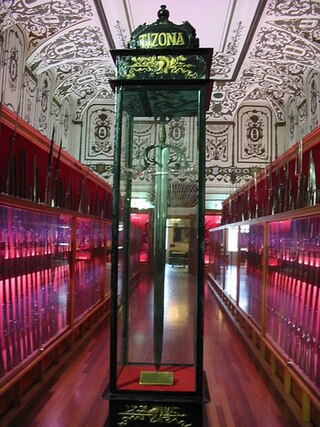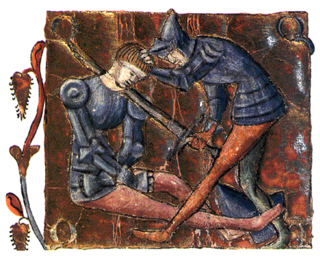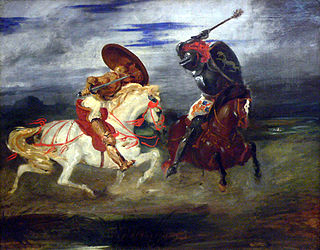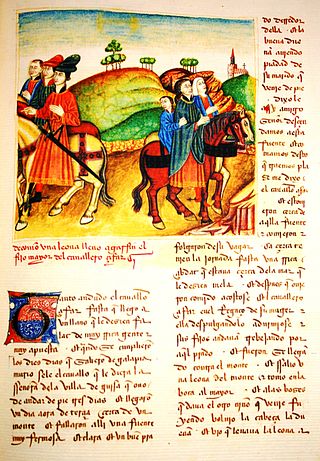History
Located on the left bank of the river Jalón as well as Ateca and Terrer, this is one of the most important castles in the development of Cantar de Mio Cid. The facts that are narrated in the Cantar, are placed in the year 1081 during the campaigns realized by El Cid during his exile. Although these facts had not been documented reliable and believed to be the exclusive fruit of the literary source of the Cantar de Mio Cid, recent archaeological discoveries, linked to the narrated in the singing, above all, referring to the campaigns in the Jalón Valley, are beginning to rethink whether what is narrated in the singing is fiction or has a histologic origin.
The name of Alcocer comes from the Arabic al-Quṣayr (القصير), meaning "the palazuelo", Arabic diminutive of al-qaṣr (القصر), "alcázar" or "the palace".
In the Cantar de Mio Cid, these verses appear:
Otro dia movios mio Çid el de Bivar
e passo a Alfama, la Foz ayuso va,
passo a Bovierca e a Teca que es adelant
e sobre Alcoçer mio Çid iva posar
en un otero redondo fuerte e grand;
açerca corre Salon, agua nol puedent vedar.
Mio Çid don Rodrigo Alcoçer cueda ganar.
This verse proves that the Alcocer quoted in the Song does not refer in any case to the Alcocer of Guadalajara. In front of these remains, crossing the river Jalon, on top of a hill, is the camp that occupied the Cid in the otero to which the Song refers is what is now called Otero del Cid or Cerro de Torrecid.

Rodrigo Díaz de Vivar was a Castilian knight and ruler in medieval Spain. Fighting with both Christian and Muslim armies during his lifetime, he earned the Arabic honorific as-Sayyid, which would evolve into El Çid, and the Spanish honorific El Campeador. He was born in Vivar, a village near the city of Burgos. As the head of his loyal knights, he came to dominate the Levante of the Iberian Peninsula at the end of the 11th century. He reclaimed the Taifa of Valencia from Muslim control for a brief period during the Reconquista, ruling the principality as its lord from 17 June 1094 until his death in 1099. His wife, Jimena Díaz, inherited the city and maintained it until 1102 when it was reconquered by the Moors.
A cantar de gesta is the Spanish equivalent of the Old French medieval chanson de geste or "songs of heroic deeds".

El Cantar de mio Cid, or El Poema de mio Cid, also known in English as The Poem of the Cid, is the oldest preserved Castilian epic poem. Based on a true story, it tells of the deeds of the Castilian hero Rodrigo Díaz de Vivar—known as El Cid—and takes place during the eleventh century, an era of conflicts in the Iberian Peninsula between the Kingdom of Castile and various Taifa principalities of Al-Andalus. It is considered a national epic of Spain.

Tizona is the name of one of the swords carried by Rodrigo Díaz de Vivar, El Cid, according to the Cantar de Mio Cid. The name of the second sword of El Cid is Colada.

Quart de Poblet is a municipality in the comarca of Horta Oest in the Valencian Community, Spain. It has 25,499 inhabitants.

The Mocedades de Rodrigo is the name given to a late, anonymous Castilian cantar de gesta, composed around 1360, that relates the origins and exploits of the youth of the legendary hero El Cid.

Cetina is a municipality in the province of Zaragoza, Aragon. It is situated at an altitude of 666 metres (2,185 ft) in the south east of the province, in the Comunidad de Calatayud, some 176 kilometres (109 mi) north east of Madrid and 98 kilometres (61 mi) south west of Zaragoza. The population in 2011 was 687.

Alhama de Aragón is a spa town located in the province of Zaragoza, Aragon, Spain, situated on the river Jalón, a tributary of the Ebro. According to the 2004 census (INE), the municipality has a population of 1,150 inhabitants.

Ateca is a municipality located in the province of Zaragoza, Aragon, Spain. At the time of the 2015 census (INE), the municipality had a population of 1,969.

Sos del Rey Católico is a historic town and municipality in the Cinco Villas comarca, province of Zaragoza, in Aragon, Spain.
Old Spanish, also known as Old Castilian, or Medieval Spanish, was originally a dialect of Vulgar Latin spoken in the former provinces of the Roman Empire that provided the root for the early form of the Spanish language that was spoken on the Iberian Peninsula from the 10th century until roughly the beginning of the 15th century, before a series of consonant shifts gave rise to modern Spanish. The poem Cantar de Mio Cid, published around 1200, is the best known and most extensive work of literature in Old Spanish.

The Battle of Morella (14 August 1084×88), southwest of Tortosa, was fought between Sancho Ramírez, King of Aragon and Navarre, and Yusuf al-Mu'tamin, King of Zaragoza, while the former was engaged in a campaign of conquest against the latter. All surviving sources for the battle are either later by a generation or literary in character, and they are confused on the chronology and dating of the event. The encounter was a defeat for Sancho and sparked a brief reversal of fortunes in the Navarro-Aragonese Reconquista. The Castilian hero, Rodrigo Díaz de Vivar, El Cid, was a general for al-Mu'tamin at the time. According to the Aragonese Crónica de San Juan de la Peña (c.1370), Sancho later sought out El Cid, who had also defeated his father in the Battle of Graus (1063), and defeated him in the year 1088. However, the Crónica is the only source mentioning such an encounter and, as it was written three hundred years later, most leading scholars give no credence to this claim, which was probably intended to justify the prerogatives of Peter IV of the Crown of Aragon.

The Marquisate of Cenete is a noble title first granted in 1491 by Queen Isabel I of Castile to Rodrigo Díaz de Vivar y Mendoza, First Count del Cid.

Belmonte de Gracián is a village near Calatayud in the province of Zaragoza in Aragon, Spain. It is a fortified village which sits at the foot of a 15th-century castle.

During the Middle Ages, Medieval Europe was engaged in constant warfare. European warfare during the Middle Ages was marked by a transformation in the character of warfare from antiquity, changing military tactics, and the role of cavalry and artillery. In addition to military, tactical and technological innovations during this period, chivalric military and religious ideals arose, giving motivation for engagement in the ceaseless warfare. In the Iberian Peninsula, chivalric ideals and institutions would be adopted and exercised with more fervour than anywhere else.

Medieval Spanish literature consists of the corpus of literary works written in medieval Spanish between the beginning of the 13th and the end of the 15th century. Traditionally, the first and last works of this period are taken to be respectively the Cantar de Mio Cid, an epic poem whose manuscript dates from 1207, and La Celestina (1499), a work commonly described as transitional between the medieval period and the Renaissance.

The Battle of Bairén was fought between the forces of Rodrigo Díaz de Vivar, also known as "El Cid", in coalition with Peter I of Aragon, against the forces of the Almoravid dynasty, under the command of Muhammad ibn Tasufin. The battle was part of the long Reconquista of Spain, and resulted in a victory for the forces of the Kingdom of Aragon and the Kingdom of Valencia.

Torrecid was a Christian motte-and-bailey castle where El Cid camped for fifteen weeks around the year 1081 according to legend. The site remained buried for almost a thousand years until recent archaeological excavations found it where Cantar de Mio Cid describes it. The site, located in the valley of the Jalón river, is in the current municipality of Ateca (Zaragoza), Spain. To date the regional Government of Aragon has not cataloged it so its protection is the generic indicated in the Decree of 22 April 1949 and Law 16/1985 of protection of the Spanish Historical Heritage.

The Way of El Cid is a cultural and tourist route that crosses Spain from the northwest to the southeast, from Castilla to the Mediterranean coast. It follows the history and the legend of Rodrigo Díaz de Vivar, El Cid Campeador, a medieval knight of the 11th century and one of Spain’s greatest characters. El Cid is not only a literary character, also a historical figure.

















